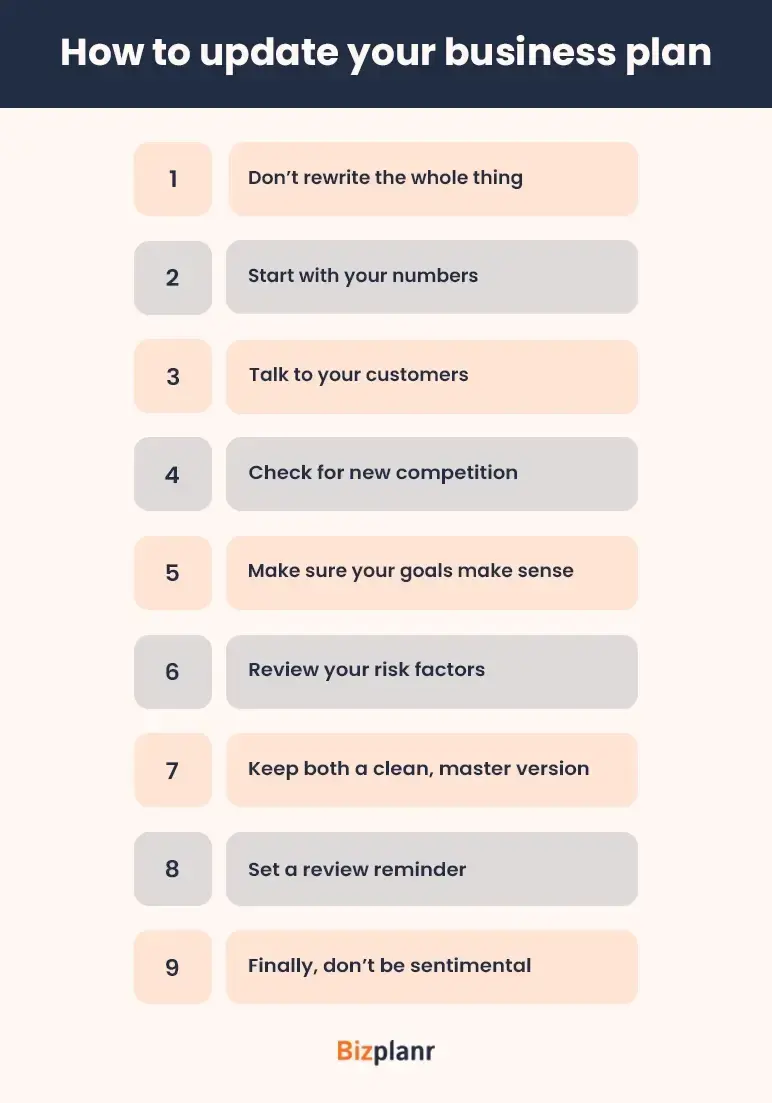Keeping your business plan up-to-date is not a one-and-done task. It’s an ongoing practice. A business plan is a living document, meant to evolve as your business and the market change.
In fact, according to a survey, businesses that regularly update their plans stay ahead, grow 30% faster, and often double their potential over time.
Now you might be thinking—how do you update a business plan? When’s the right time, and what exactly should you change?
Relax, you’re in the right place. In this blog, I’ll break it all down for you in simple, clear language.
Let’s dive in.
How often should you update your business plan? (quick answer)
To keep your business moving without disruptions, it’s best to update your business plan every 3-6 months, or at least once a year.
Regularly updating your business plan improves performance, identifies risks, and helps you make informed decisions.
Let’s have a deeper look at how often you should update your business plan:
| Situation | How Often | Types of Businesses |
|---|---|---|
| Regular review | Once a year (12 months) | Small & Medium Businesses |
| Frequent strategy review | Every 3-6 months | Enterprises & Large Corporations |
| New product/service launch or technology advancement | Immediately | Small, Medium & Large Businesses |
| To improve profits/performance | Every 3 months | All Business Sizes |
Is it necessary to keep updating your business plan?
No, it’s not mandatory. But it’s one of those smart habits that keeps you ahead of trouble. Markets shift, customer expectations evolve, new competitors appear, and opportunities you hadn’t thought of can appear out of nowhere.
That’s why, even though it’s not a strict rule, regularly reviewing and updating your business plan is a smart and healthy business practice.
Here’s why it’s worth doing:
- Markets change, and if your plan doesn’t, you risk falling behind.
- Customer needs evolve—what people wanted six months ago might not be what they need today.
- Competitors are always adjusting their game; you need to stay one step ahead.
- New opportunities come up, and your old plan might not be designed to take advantage of them.
- Strategies that worked last year might not work in the current market climate.
- Your financial projections should be checked regularly to avoid surprises and adjusted for actual performance.
- When you add new products, services, or team members, your plan should reflect those changes.
- It keeps you clear-headed, focused, and aligned with your long-term business goals.
In short, while you don’t have to do it, updating your business plan regularly is what separates businesses that react to problems from those that are ready for them.
When to update your business plan?
One mistake people often make is treating a business plan like a one-time thing. You write it, pitch it to the bank or investors, and then forget it on a shelf. That’s how businesses get blindsided.
A business plan isn’t just for raising money—it’s your guidebook. And if your path changes, or the weather gets rough, you need to adjust your route. So let’s talk about when it makes sense to update it.
1) After a major milestone (Product launch, funding round, expansion)
Say you launch a new product—suddenly your marketing costs go up, you might need extra staff, or your profits take a dip before things stabilize. That changes your cash flow, your sales projections, your operational focus — basically everything.
The same goes if you close a big funding round or decide to open a new branch. Those are big moments. And your business plan should reflect where you stand after those changes, not where you were before.
I always say—when the business takes a big step forward, your plan should too.
2) Regular review
Now, this one’s easy to overlook. Most people think, “If things are going fine, why bother?” But remember, even a car needs servicing when it’s running smoothly.
Most businesses do a formal strategy review either once a year or every six months. Right after that review is the perfect time to open up your business plan and see if your actual results match what you had planned.
If they don’t adjust. If you beat your targets, raise your benchmarks. If you missed them, figure out why and correct your course.
Quick table for you:
| Business Type | Recommended Review Frequency |
|---|---|
| Startups & High-Growth Firms | Every 3-6 Months |
| Small to Medium Businesses | Every 6-12 Months |
| Large Enterprises | Annually |
3) Following a performance review
Now, imagine you sit down every quarter to check your sales numbers, profits, and customer feedback. If you notice something’s consistently off, maybe your profits are dropping or a product isn’t performing like you thought, that’s your cue.
Don't just shrug it off. Open that business plan, revisit your goals, adjust your strategies, and fine-tune your budget. A business plan is a living thing. It needs to stay aligned with your actual performance.
4) After a market disruption or global event (Like a pandemic)
Let me give you a real-world example: When COVID-19 hit, businesses that updated their plans quickly survived better. Restaurants moved to delivery, fitness centers started virtual classes, and local shops switched to online orders.
If your plan says, “50% revenue from in-store customers”, but the government shuts down your store, you’ve got to pivot. Fast.
In times like these, you don’t wait for the next quarterly review—you sit down immediately, assess the damage, and rework your plan.
5) When entering a new market or launching a new service
Anytime you decide to offer something new or enter a new market, it’s like adding a new player to your team. The whole game changes.
You need to do fresh market research, understand new competitors, figure out pricing, marketing, financial projections, and operational adjustments. Your business plan should document this shift.
Never run new ideas on old plans; it’s like fixing a new engine in an old car without checking if it fits.
6) When technology, law, or industry trends shift
Sometimes, a new technology comes up, or government regulations change, and the way you’ve been doing business won’t work anymore.
Like how social media completely changed how businesses advertise, or how Donald Trump's administration introduced new tariffs on imported products, it shook up entire industries overnight.
When the rules of the game change, you don’t keep playing with the old playbook. Update your business plan to stay ahead, not just survive.
How to update your business plan (practical tips)
Now that you know when to update your business plan, let’s talk about how to actually do it the right way:
Don’t rewrite the whole thing unless you have to
Most times, you’ll only need to tweak certain sections — maybe your financial forecasts, marketing strategy, or business goals. Keep what’s still working and only adjust what’s outdated.
Start with your numbers
Before you touch anything else, review your latest financial statements, sales reports, and market data. If your numbers have changed, your strategies probably need to as well.
Talk to your customers and your team
Sometimes the best insights come from the shop floor, not the boardroom. Ask your frontline people and loyal customers what’s working and what’s not. You’ll find things your reports won’t tell you.
Check for new competition and market trends
New players or fresh trends can make your old strategies obsolete. Keep an eye on what your competitors are doing and what’s changing in your industry. If you’re not adjusting, you’re falling behind.
Make sure your goals make sense
What seemed like a good target last year might be unrealistic or too easy now. Update your short-term and long-term goals based on how things are moving.
Review your risk factors
Every few months, ask yourself—what new risks are out there? It could be a new regulation, a supply chain issue, or a market slowdown. Add them to your plan so you’re prepared.
Use simple, clear language
Avoid corporate jargon. Write your plan so that if your friend’s teenage kid reads it, he gets the gist. A clear plan is a usable plan.
Keep both a clean, master version and a working draft
One mistake people make is editing the only copy they have. Keep a clean version as your official file, and work on a draft when making changes. When it’s final, replace the master.
Set a review reminder
Don’t wait for a crisis to make you open your business plan. Set a calendar reminder every 6 months or after key events so it becomes a habit, not an emergency.
Finally, don’t be sentimental
Just because you loved an idea last year doesn’t mean it belongs in your plan now. Business is practical, not personal. Keep what works, drop what doesn’t.
Conclusion
Hence, proven! A business plan is not stagnant, but it’s a living asset that should be updated at regular intervals. In this blog, we discussed the timings, methods, and process to update your business plan.
I’m sure with the help of this blog, your business will experience flexibility that will help you adopt changes, keep your business ahead, and help you make informed decisions.
However, updating your business plan is a complex and lengthy process; leveraging the assistance of AI can cut down your time and resources to update a business plan. A platform like Bizplanr can help you update your business plan in minutes; all you need is to provide basic information about your business.
Ready to update your business plan? Get started with Bizplanr.
Get Your Business Plan Ready In Minutes
Answer a few questions, and AI will generate a detailed business plan.
Frequently Asked Questions
How often should a business plan be updated?
Ideally, you should revisit your business plan every 6 to 12 months, or whenever there’s a major change in your market, finances, or operations. It’s like tuning a car—even if it’s running fine, regular check-ups keep it smooth.
What are the key areas to focus on when updating a business plan?
Always pay close attention to your financial projections, market analysis, business goals, and operational plans. Those are the parts that move fastest in any business, and if they’re outdated, the whole plan can lose its value
Will updating my business plan affect investor confidence?
Actually, quite the opposite. Serious investors appreciate founders who stay on top of their numbers and market shifts. A well-maintained, updated business plan shows you’re proactive and serious about your growth.
What if things are going well—do I still need to update it?
Absolutely. When things are going well is the perfect time to refine your strategy, spot new opportunities, and prepare for future risks. Waiting until problems hit is like fixing a leaky roof during a storm.
What tools can help me update my business plan efficiently?
You don’t have to do everything manually. Tools like LivePlan, Bizplan, or even a well-organized Google Workspace setup can help you track changes, collaborate with your team, and manage financial forecasts easily without starting from scratch each time.








